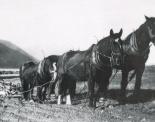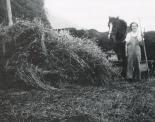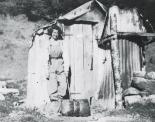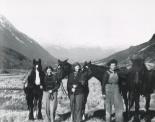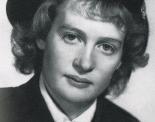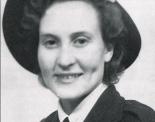LAND GIRLS Gallery
In April many of our thoughts turn to ANZAC Day and the history of those who fought overseas during the wars. We tend to forget that as the men went off to war, farms still needed to produce (even moreso as they were supplying not only a domestic market but also for thousands of soldiers stations in the Pacific), and businesses still needed to function. Who filled in the gap?
This month our photos feature three women who served in the New Zealand Women’s Land Service: Reta and Betty Groves (later Reta Thomson and Betty Watson) of Routeburn Station and Betty Shaw (later Betty Boyd) of Elfin Bay.
The idea of a Women’s Land Service came from programs that had been set in place in both the United Kingdom and Australia at the outset of WWII. In both countries, these were Land Armies where the women serving had ranks and stripes. In New Zealand, there was much controversy and opposition over whether or not women should be in these roles and it took until 1941 for the Land Service to get started and only in late 1942 did the women receive uniforms and pay. A woman in the Land Service working on a sheep farm was paid 30/- at the outset and could move up to 35/- a week for her work. As Dianne Bardsley writes in her wonderful book, The Land Girls: In a Man’s World 1939-1946, “Throughout the nation, for the first time, women were in paid employment on farms, making administrative decisions…Their task was to maintain and increase production from the rural sector.”
Over 4,000 women applied to the Land Service. There were no deserters and no defaulters. In the span of the war, 2711 were placed on 2963 farms and wartime agricultural production was higher than the years before.
Here at the Head of the Lake, Reta and Betty Groves had to take on a wide range of tasks at Routeburn Station. In their recollections they describe:
Our truck and horses weren’t commandeered because they were really too isolated for the Army to transport them and after we joined the Land Service, there were no visits from the Manpower Office staff to see if we were still alive!...
We shot rabbits and caught possums and stretched and sold their skins. Skinning them in our winter temperatures made hard work for our frozen fingers! We shot plenty of wild deer and would sell the skills and tails and use the meat for venison or for dog-tucker. We caught trout and ran pigs and out father cured our bacon.
Both Reta and Betty learned to shear using blade shears and could shear 100 Romney-Merino cross in a day. In summer, they, along with cousin Shirley Groves (later Shirley McGregor), they cut all of the hay and oats for four stations. They recollected:
Our summers were really hot and dry and it was hot work but we enjoyed moving around the four stations with our stacking. We didn’t consider it hard at the time and we were provided with marvelous food!
On Elfin Bay Station, Betty, her sister, and father were responsible for 200 Hereford grazing in the Greenstone Valley and 3,000 merinos. Leading a similar life of hunting, fishing, rabbiting, butter making, mustering and shearing, Betty described:
I did all the sheep work, including blade shearing. I could blade-shear up to ninety a day… it was a great life. We loved the mountains and the lake. It was cold to swim in, but we swam in the lake and we caught trout in it, too. We shot and skinner deer and rabbits and sold their skins. The dogs had their meat.
Wonderful photos capture Betty in backcountry huts mustering and in the winter, snow raking.
Along with farming work, Betty and Reta Groves also stepped in to help out after Harry Bryant’s Kinloch bus drivers enlisted in 1942. Keeping tourism alive in the district, they were able to meet up to 40 passengers who would come off the Earnslaw and drive them over 16 fords to the Routeburn, boil up tea for them in a billy and then take them back in time to catch the 3:30 sailing of the Earnslaw back to Queenstown.
As we think back on wartime New Zealand this month, we would like the honour the contributions of women like Betty and Reta Groves, Betty Shaw, and so many other women whose hard work kept farms and businesses going during the war and and afterwards made wonderful contributions to the community.
In 2011 the New Zealand Government officially recognized the service of Land Girls.
With thanks to Dianne Bardsley’s book The Land Girls: In a Man’s World 1939-1946 for her interviews and photos with Reta, Betty, and Betty. Thanks, too, for help from Elaine Kirkland and Geoffrey and Diana Thomson.
To read more about Land Girls:
https://nzhistory.govt.nz/media/video/land-girls-overalls-and-killing-knife
https://www.odt.co.nz/regions/central-otago/ww2-land-girl-recognised-services-70-years
http://www.localmatters.co.nz/News/Mahurangi+News/Mahurangi+News+archives/News+-+April+13+2011/Land+girls+recognition+tinged+with+sadness.html
http://www.stuff.co.nz/taranaki-daily-news/news/south-taranaki-star/72877131/award-finally-recognises-former-landgirls-hard-work-during-world-war-ii


